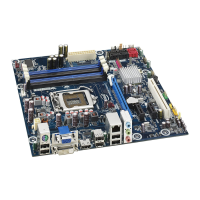Intel Desktop Board DH55HC Technical Product Specification
54
2.6 Thermal Considerations
CAUTION
Use of a processor heat sink that provides omni-directional airflow to maintain
required airflow across the processor voltage regulator area is highly recommended.
CAUTION
Failure to ensure appropriate airflow may result in reduced performance of both the
processor and/or voltage regulator or, in some instances, damage to the board. For a
list of chassis that have been tested with Intel desktop boards please refer to the
following website:
http://www3.intel.com/cd/channel/reseller/asmo-na/eng/tech_reference/53211.htm
All responsibility for determining the adequacy of any thermal or system design
remains solely with the reader. Intel makes no warranties or representations that
merely following the instructions presented in this document will result in a system
with adequate thermal performance.
CAUTION
The ambient temperature must not exceed the board’s maximum operating
temperature. Failure to do so could cause components to exceed their maximum case
temperature and malfunction. For information about the maximum operating
temperature, see the environmental specifications in Section 2.8.
CAUTION
Ensure that proper airflow is maintained in the processor voltage regulator circuit.
Failure to do so may result in damage to the voltage regulator circuit.
Figure 16 shows the locations of the localized high temperature zones.

